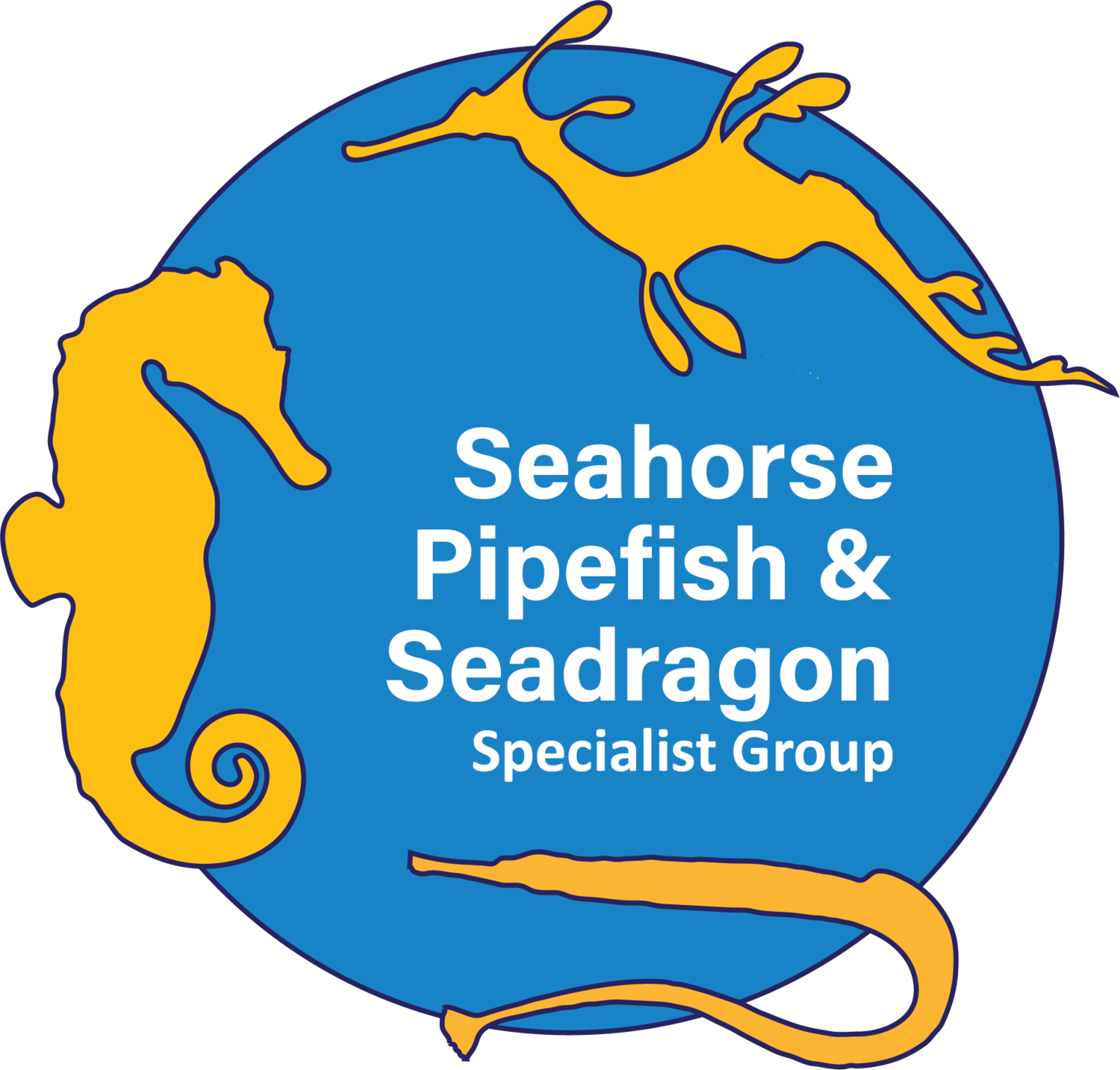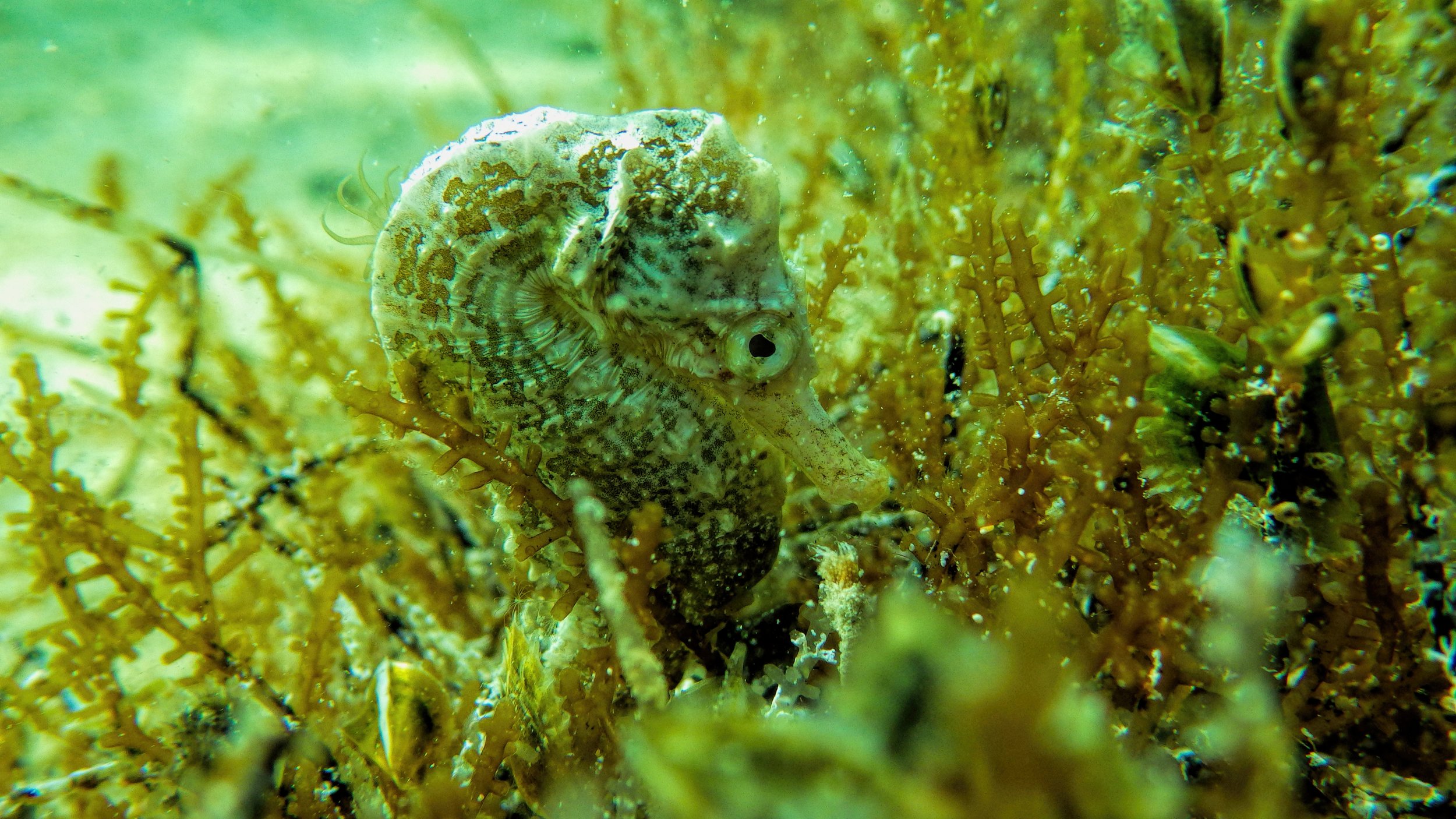Sustainable seahorse, pipefish, and seadragon tourism
Position statement on tourism interactions with seahorses, pipefish, and seadragons (syngnathid fishes):
concerns, recommendations, code of conduct and best practices
Introduction
Observing and photographing marine wildlife is a large proportion of the tourism economy, creating millions of jobs globally in potentially sustainable livelihoods1,2. Seahorses, pipefishes, pipehorses and seadragons (family Syngnathidae) are threatened by human impacts such as habitat destruction and overfishing3,4, but are also some of the most popular species in under water tourism5, helping to generate millions of dollars for local communities1. The experience of observing seahorses or their close relatives, the pipefishes and seadragons, in their natural habitats is often the highlight of a holiday, creating lifelong memories and sometimes even inspiring people to help protect these unique animals. As such, wildlife tourism has the potential to be a force of good for the protection of these amazing but threatened fishes, if well managed.
Kulbicki's pipefish (Fastucalex kulbickii ).
Photo by Richard Smith.
Concerns
Tourism comes with inherent risks to the environment and species of interest. Poorly managed tourism can impact the health of key species and their habitats, or even inadvertently kill them. In some cases, the curio trade in tourism locations directly targets the species supporting the tourism industry. For threatened species such as seahorses and their relatives, the effect of tourism impacts could be substantial.6,7
The most obvious impacts can include physical damage or even mortality through direct handling or other unethical practices. Often though, impacts are less visible and over longer periods.7,8 These include long-term decrease in overall health of animals, or indirectly through damage to essential habitats caused by divers or snorkelers, boat anchors, or poor development planning.7,9
Appropriate wildlife tourism management, and specifically the management of interactions with seahorses and their relatives, is approached in different ways by tourism stakeholders across the world. Regulations globally vary from highly restrictive to non-existent, resulting in varying conservation and tourist engagement outcomes.9,10
Recommendations
As the designated global authority on seahorses and their relatives, the IUCN SSC Seahorse, Pipefish & Seadragon Specialist Group (SPS SG) is supportive of sustainable syngnathid tourism. We acknowledge that well-managed tourism can create alternative livelihoods, sustain local communities, and promote interest and conservation actions for syngnathids.
The SPS SG emphasizes that wildlife interactions must be conducted in a way which is not detrimental to syngnathids or their habitats. We strongly urge national and regional management bodies to engage with local communities to improve tourism outcomes and to adopt the syngnathid tourism guidelines developed by the IUCN SPS SG which provide a clear code of conduct based on up-to-date scientific knowledge. The IUCN SPS SG can help provide accurate information for stakeholders wishing to adapt these guidelines to their local contexts.
Based on the current science-based knowledge available on the potential effects of tourism on seahorses and their relatives, we present the recommendations below, envisioning effective movement towards an ethical and sustainable approach to interactions with these unique and threatened animals.
Lined seahorse (Hippocampus erectus).
Photo by Heather Mason
Code of Conduct and Best Practices for Syngnathid Tourism
The Syngnathid Tourism Code of Conduct provides best practice guidelines for observing, photographing, or filming seahorses, pipefishes, pipehorses, and seadragons (syngnathid fishes) in the wild. It was developed based on the best available scientific knowledge by the IUCN SSC SPS SG, the global authority on seahorses and their relatives.
The Code of Conduct is aimed at tourists, divers, and snorkelers interacting with syngnathids, tourism operators who provide wildlife tourism services, and management bodies who regulate wildlife tourism. The Code of Conduct was not designed to provide advice for syngnathid tourism in zoos or aquaria, but the same general principles apply for these environments.
Tourism operators are encouraged to adhere to the IUCN SPS SG Syngnathid Tourism Code of Conduct when interacting with seahorses, pipefishes, pipehorses, and seadragons and urge tourists to do the same. Management bodies are encouraged to integrate the Syngnathid Tourism Code of Conduct into legal frameworks to ensure ethical and sustainable tourism practices.
General guidance
Syngnathid tourism management should aim to minimise impacts on animals and their habitat, while also recognizing the potential benefits of tourism to local livelihoods.
During interactions with seahorses, pipefishes, pipehorses, and seadragons, people should always avoid: (i) touching animals; (ii) removing animals out of their habitats; or (iii) otherwise disturbing animals.
Tourism activities should avoid damaging habitat by avoiding/reducing direct impacts of divers/snorkelers and practising sustainable anchoring practices.
Long-snouted seahorse (Hippocampus guttulatus).
Photo by Miguel Correia / Project Seahorse
Direct interactions
Never touch syngnathids.
Never capture, manipulate, or remove syngnathids from the water or their habitat.
Do not infringe upon the immediate space (30cm ≈ 1 foot) of the animals. Humans are perceived as threats or predators by syngnathids, which can cause stress.
Limit the amount of time spent in close proximity (30cm ≈ 1 foot) with seahorses, particularly in popular dive areas where multiple divers / snorkelers will visit the same sites.
Do not surround syngnathids with large (>4) groups of divers / snorkelers. Always allow an easy way for the fish to escape and leave the area.
If an animal looks stressed (erratic movements, swimming away, rapid movement of gill plates), move away. Remember that many syngnathid species react to stress (i) by holding on more tightly and (ii) will hesitate to leave an area even if very stressed.
Never move or encourage, coax, or force syngnathids to move. It is common to find seahorses lying motionless on the seafloor. Leave them be.
Never use a muck/pole diving stick, or other implements to touch or scare animals into changing position.
Habitat protection
Do not touch the habitat or holdfast of syngnathids.
Do not walk on syngnathid habitats such as seagrass beds or coral reefs.
Avoid damaging habitat by practising good buoyancy, securing equipment, dive guide interventions, not stepping on fragile seafloors, etc. Be mindful of camera gear and the effect of exhaled bubbles on fragile habitat such as seafans.
Do not stir up silt with your feet or fins as you may injure the animals, as well as making it harder to find them.
Be mindful of camera gear and the effect of exhaled bubbles on fragile habitat such as seafans.
Use sustainable anchoring and boat mooring practices. Do not anchor boats in critical habitats such as coral reefs or seagrass beds. Reduce the impacts of moorings by installing them in low impact zones or using ‘eco-mooring’ designs.
Leafy seadragon (Phycodurus eques).
Photo by Gaetano Gargiulo / Guylian Seahorses of the World
Photography / videography
Be aware of the condition of the animal at all times. If it looks stressed (e.g. erratic movements, swimming away, rapid movement of gill covers), stop the activity you are doing and move away.
Touching syngnathids, approaching them too closely (30cm ≈ 1 foot), or interacting with them for too long will cause harm or stress to the animals.
It is acceptable to use flash photography in moderation, research shows flash photography will not damage the eyes of syngnathids.
The bright constant lights of underwater torches or strong video lighting systems have been documented to disturb syngnathids. Limit the use of such systems and stop their use immediately if the animals appear stressed (e.g. erratic movements, swimming away, rapid movement of gill covers).
Do not infringe upon the immediate space (30cm ≈ 1 foot) of the animals. Humans and camera systems are perceived as threats or predators by syngnathids, which can cause stress.
Never use a muck/pole diving stick, or other implements to touch or scare animals into changing position.
Environmental awareness
Never sell or buy souvenirs made from syngnathids, their habitat, or other marine life (e.g. corals, shells, starfish, and more…).
Educate yourself about how you can help conserve seahorses by visiting www.projectseahorse.org and https://projectseahorse.org/take-action.
Support local communities and tourism operators that follow sustainable tourism practices such as GreenFins.
Do not eat unsustainably sourced seafood. One of the leading causes of seahorse declines is through them being caught by nonselective and destructive fishing gears, particularly by bottom trawling. Find more information about bottom trawling and sustainable seafood on www.projectseahorse.org or www.msc.org.
References
1 Balmford, A., Beresford, J., Green, J., Naidoo, R., Walpole, M., & Manica, A. (2009). A global perspective on trends in nature-based tourism. PLoS biology, 7(6): e1000144. https://doi.org/10.1371/journal.pbio.1000144
2 De Brauwer, M., Harvey, E. S., McIlwain, J. L., Hobbs, J. P. A., Jompa, J., & Burton, M. (2017). The economic contribution of the muck dive industry to tourism in Southeast Asia. Marine Policy, 83:92-99. https://doi.org/10.1016/j.marpol.2017.05.033
3 Vincent, A. C., Foster, S. J., & Koldewey, H. J. (2011). Conservation and management of seahorses and other Syngnathidae. Journal of fish biology, 78(6), 1681-1724. https://doi.org/10.1111/j.1095-8649.2011.03003.x
4 Pollom, R. A., Ralph, G. M., Pollock, C. M., & Vincent, A. C. (2021). Global extinction risk for seahorses, pipefishes and their near relatives (Syngnathiformes). Oryx, 55(4), 497-506. https://doi.org/10.1017/S0030605320000782
5 De Brauwer, M., & Burton, M. (2018). Known unknowns: Conservation and research priorities for soft sediment fauna that supports a valuable SCUBA diving industry. Ocean & Coastal Management, 160, 30-37. https://doi.org/10.1016/j.ocecoaman.2018.03.045
6 De Brauwer, M., Saunders, B. J., Ambo-Rappe, R., Jompa, J., McIlwain, J. L., & Harvey, E. S. (2018). Time to stop mucking around? Impacts of underwater photography on cryptobenthic fauna found in soft sediment habitats. Journal of environmental management, 218:14-22. https://doi.org/10.1016/j.jenvman.2018.04.047
7 Trave, C., Brunnschweiler, J., Sheaves, M., Diedrich, A., & Barnett, A. (2017). Are we killing them with kindness? Evaluation of sustainable marine wildlife tourism. Biological conservation, 209:211-222. https://doi.org/10.1016/j.biocon.2017.02.020
8 De Brauwer, M., Gordon, L. M., Shalders, T. C., Saunders, B. J., Archer, M., Harvey, E. S., ... & McIlwain, J. L. (2019). Behavioural and pathomorphological impacts of flash photography on benthic fishes. Scientific reports, 9(1):748. https://doi.org/10.1038/s41598-018-37356-2
9 Roche, R. C., Harvey, C. V., Harvey, J. J., Kavanagh, A. P., McDonald, M., Stein-Rostaing, V. R., & Turner, J. R. (2016). Recreational diving impacts on coral reefs and the adoption of environmentally responsible practices within the SCUBA diving industry. Environmental Management, 58(1):107-116. https://doi.org/10.1007/s00267-016-0696-0
10 Marine Management Organisation. (2014). The effects of flash photography on UK seahorse species. A report produced for the Marine Management Organisation MMO Project No. 1005b, 21pp. https://webarchive.nationalarchives.gov.uk/ukgwa/20140305093301mp_/http://www.marinemanagement.org.uk/evidence/documents/1005b.pdf
Additional useful references and resources
Cullen-Unsworth, L.C. & Unsworth, R.K. (2016). Strategies to enhance the resilience of the world's seagrass meadows. Journal of Applied Ecology, 53(4):967-972. https://doi.org/10.1111/1365-2664.12637
Giglio, V.J., Ternes, M.L., Kassuga, A.D. and Ferreira, C.E. (2019). Scuba diving and sedentary fish watching: effects of photographer approach on seahorse behavior. Journal of Ecotourism, 18(2):142-151. https://doi.org/10.1080/14724049.2018.1490302
Harasti, D. & Gladstone, W. (2013). Does underwater flash photography affect the behaviour, movement and site persistence of seahorses? Journal of Fish Biology, 83(5): 1344-1353. https://doi.org/10.1038/s41598-018-37356-2
Harasti, D. (2016). Declining seahorse populations linked to loss of essential marine habitats. Marine Ecology Progress Series, 546:173-181. https://doi.org/10.3389/fmars.2022.867352
Knopf, K., Buschmann, K., Hansel, M., Radinger, J. & Kloas, W. (2018). Flash photography does not induce stress in the Ram cichlid Mikrogeophagus ramirezi (Myers & Harry, 1948) in aquaria. Journal of Applied Ichthyology, 34(4):922-928. https://doi.org/10.1111/jai.13673
Luff, A.L., Sheehan, E.V., Parry, M. & Higgs, N.D. (2019). A simple mooring modification reduces impacts on seagrass meadows. Scientific Reports, 9(1):20062. https://doi.org/10.1038/s41598-019-55425-y
Smith, R.E. (2010). The biology and conservation of gorgonian-associated pygmy seahorses. PhD thesis, The University of Queensland, Brisbane, Australia.
oceanrealmimages.com/pygmy-seahorses/code-of-conduct/
Banner image of Denise’s pygmy seahorse (Hippocampus denise) © Kathrin Landgraf-Kluge / Guylian Seahorses of the World
[Page updated 12 July 2023]





